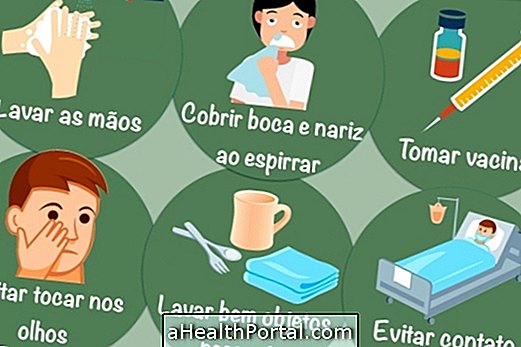Influenza A is one of the main types of influenza that appears every year, most often in winter. This flu can be caused by two variants of the virus Influenza A, H1N1 and H3N2, but both generate similar symptoms and are also treated equally.
Influenza A tends to evolve in a very aggressive way if not treated properly, so it is very important to see a doctor if you suspect that you have influenza A, because otherwise it can cause more serious complications, such as the distress syndrome. respiratory disease, pneumonia, respiratory failure or even death.

Main symptoms
The main symptoms of influenza A are:
- Fever above 38 ºC and which appears suddenly;
- Body pain;
- Sore throat;
- Headache;
- Cough;
- Sneezing;
- Chills;
- Shortness of breathe;
- Fatigue or tiredness.
In addition to these symptoms and constant discomfort, diarrhea and some vomiting may also appear, especially in children, which end up passing over time.
How to know if it is influenza A?
Although the symptoms of influenza A are very similar to that of the common flu, they tend to be more aggressive and intense, often requiring you to stay in bed and rest for a few days, and often their appearance has no warning, appearing almost suddenly.
In addition, influenza A is highly contagious, making it very easy to transmit to other people with whom you have been in contact. If there is a suspicion of this flu, it is recommended that you wear a mask and go to the doctor, so that tests that confirm the presence of the virus can be performed.
What is the difference between H1N1 and H3N2?
The main difference between the flu caused by H1N1 or H3N2 is the virus itself that causes the infection, however, the symptoms, treatment and form of transmission are similar. These two types of viruses are present in the flu vaccine, together with Influenza B, and therefore, whoever vaccines against influenza every year is protected against these viruses.
However, the H3N2 virus is often confused with H2N3, another type of virus that does not affect humans, spreading only between animals. In fact, there is no vaccine or treatment for the H2N3 virus, but only because that virus does not affect humans.
How the treatment is done
Treatment for influenza A is done with antiviral drugs like Oseltamivir or Zanamivir and generally the treatment works best if it is started within the first 48 hours after the first symptoms appear. In addition, the doctor may also recommend remedies to relieve symptoms such as Paracetamol or Tylenol, Ibuprofen, Benegripe, Apracur or Bisolvon, for example, which relieve symptoms such as fever, sore throat, cough or muscle pain.
To complement the treatment, in addition to the remedies it is also recommended to rest and maintain hydration by drinking plenty of water, it is not recommended to go to work, go to school or go to places with many people while you have the flu. The treatment can also be complemented with natural remedies, such as ginger syrup, for example, which has analgesic, anti-inflammatory and expectorant properties, being great for flu. Here's how to prepare ginger syrup.
In addition, to prevent influenza A and its possible complications, a flu vaccine is available, which helps to protect the body against the main types of viruses that cause influenza.
In cases where the person does not improve with the treatment and ends up evolving with complications, such as severe shortness of breath or pneumonia, it may be necessary to stay in hospital and in respiratory isolation, to take medications in the vein and do nebulizations with medications, and may even need orotracheal intubation to relieve respiratory distress and treat flu.

When to get the flu vaccine
To avoid catching influenza A, a flu vaccine is available that protects the body against the most common flu viruses, such as H1N1, H3N2 and Influenza B. This vaccine is especially indicated for some risk groups that are more likely to get the flu, namely:
- Elderly people over 65 years old;
- People with compromised immune systems, such as people with AIDS or myasthenia gravis;
- People with chronic diseases, such as diabetics, liver, heart or asthma patients, for example;
- Children under 2 years of age;
- Pregnant women, as they cannot take medication.
Ideally, the vaccine should be made every year to ensure effective protection, as each year new flu virus mutations appear.
How To Avoid Getting A Flu
To avoid catching influenza A, there are some measures that can help prevent contagion, it is recommended to avoid staying indoors or with many people, washing your hands regularly, always covering your nose and mouth when coughing or sneezing and avoid contact with people who have flu symptoms.
The main form of contagion of influenza A is through the respiratory route, where it is only necessary to breathe droplets that contain the H1N1 or H3N2 virus, to run the risk of getting this flu.
Was this information helpful?
Yes No
Your opinion is important! Write here how we can improve our text:
Any questions? Click here to be answered.
Email in which you want to receive a reply:
Check the confirmation email we sent you.
Your name:
Reason for visit:
--- Choose your reason --- DiseaseLive betterHelp another personGain knowledge
Are you a health professional?
NoMedicalPharmaceuticalsNurseNutritionistBiomedicalPhysiotherapistBeauticianOther







-o-que--sintomas-e-tratamento.jpg)


















